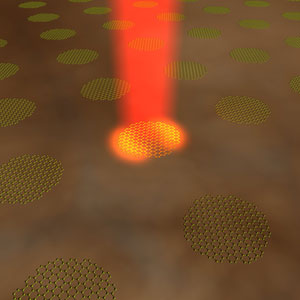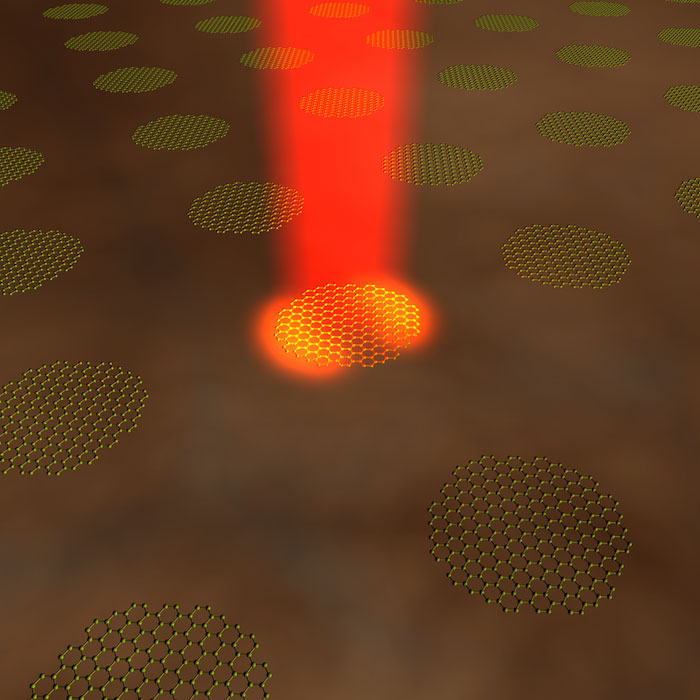Graphene Arrays Could Be Perfect Absorbers
In many optical devices, such as photodetectors, researchers need to capture as much light as possible and minimize the amount of reflected light. Writing in Physical Review Letters, a team calculates that a sheet of nanoscale structures, such as disks of single-atom-thick graphene, could absorb all incoming light of a chosen frequency and reflect none of it. Such a patterned layer could benefit proposed graphene-based devices that need to absorb infrared light efficiently at specific wavelengths, such as spectrometers.
Since researchers first learned how to create isolated sheets of graphene—a single layer of pure carbon—less than a decade ago, they have demonstrated many exotic properties of its effectively two-dimensional electrons. In one striking example, the amount of light absorbed is pi times the so-called fine structure constant [1]. At percent, this absorption is huge for such a thin layer, but percent of the light still gets away, making graphene-based optical devices inherently inefficient.
But dividing up a graphene sheet into an array of nanoscale disks or other structures on a surface could dramatically enhance the absorption, says Javier García de Abajo of the Institute of Physical Chemistry “Rocasolano” (IQFR-CSIC) in Madrid and the University of Southampton, England. He and his team started with the idea that in a graphene disk, electrons can slosh from side to side at a characteristic frequency, much like water in a bathtub. Light at or near this frequency—which is in the infrared range—can set this sloshing “plasmon” in motion. According to the team’s theory, the sloshing electrons generate their own electric field that, when added to that of the incoming light, dramatically reduces the amount of reflected light, compared with any ordinary surface. Each disk absorbs as much light as would be expected for one several times its area, which is similar to the enhancement of absorption that occurs for an ordinary radio antenna at its characteristic frequency.
The researchers calculate that an array of such dots can absorb percent of the light energy hitting it, as long as the light frequency matches the plasmon frequency. The theory predicts a similar effect for any array of sufficiently strong oscillators, such as metallic nanoparticles, not just graphene, García de Abajo says. “The fact that complete absorption can be understood in such simple terms is new.”
Some previous techniques for reducing reflection, such as anti-reflection coatings on eyeglasses, exploit interference between reflections that come from different layers of a structure, which happens only for specific frequencies and angles. In this new proposal, by contrast, the high absorption should occur for light impinging from any angle, although still only over a narrow frequency range. The frequency could be adjusted by adding electrons to the graphene, either electrically or chemically, or by changing the geometrical arrangement of the graphene structures, says García de Abajo. So he imagines, for example, that arrays of disks or other nanostructures could be part of a system for detecting chemicals by measuring their spectra in a relatively inaccessible range of infrared wavelengths.
“The topic is extremely appealing” for graphene researchers, says Andrea Ferrari of the University of Cambridge, England, because in optical devices “you want to have a very high absorption.” But he says there are other approaches being studied, including experiments showing absorption above percent. Although the new work is still theoretical, Ferrari says, in graphene “there has been a short period of time between theoretical proposals and practical implementations.”
–Don Monroe
Don Monroe is a freelance science writer in Murray Hill, New Jersey.
References
- K. F. Mak, M. Y. Sfeir, Y. Wu, C. H. Lui, J. A. Misewich, and T. F. Heinz, “Measurement of the Optical Conductivity of Graphene,” Phys. Rev. Lett. 101, 196405 (2008)





